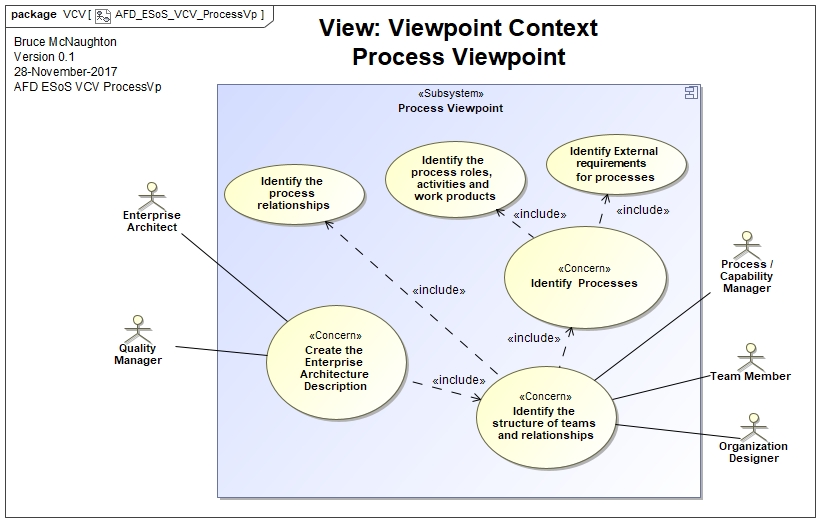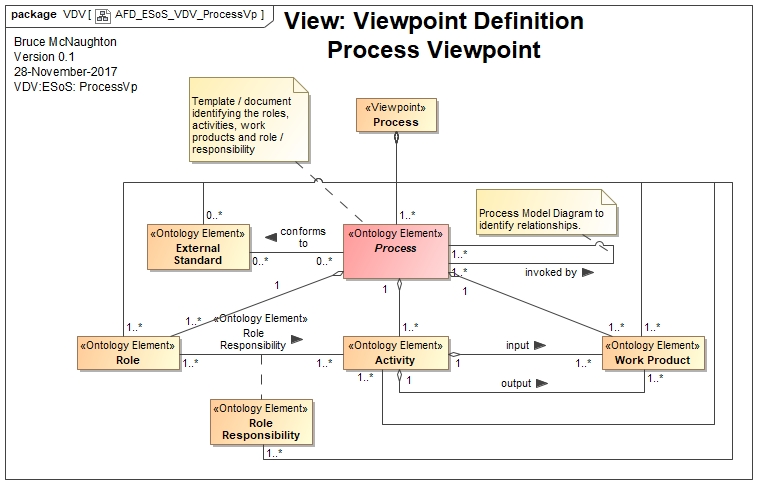Description
The Process Viewpoint describes the approach to creating the Process View for an Architecture Description.
A process![]() set of interrelated or interacting activities that use inputs to deliver an intended result. ISO 9000:2015. is a set of interrelated or interacting activities that use inputs to deliver an intended result. ISO 9000:2015.
set of interrelated or interacting activities that use inputs to deliver an intended result. ISO 9000:2015. is a set of interrelated or interacting activities that use inputs to deliver an intended result. ISO 9000:2015.
Activities:descriptions of two or more activities to be carried out by people in the organisation. The activities also identify the Technology Interaction Points.
Inputs: The work products to be used or conditions necessary to carry out the activity
Interrelated or interacting: The activities within the process work together to produce the intended results required to achieve the objectives and goals of the process.
Intended Result: The intended result can be an output of a process, a product or service from the organisation. Other terms used are work product, outcome, etc.
Processes are a critical / essential element of any Capability. The processes identify the work (activities / decisions ) needed to be carried out by a person assigned to a role to deliver the capabilities to contribute to the purpose of the management system.
The process viewpoint provides a view across all of the work performed in the management system. . The Process Model is used to identify the processes and their relationships for the whole organization . These processes also align to the Capability Model.
The following are the main types of processes found in the Integrated Management System:
- Management Processes.
- Innovation and Development Processes.
- Product and / or Service Delivery Processes.
Each process is fully defined using the Work Product: Process Description. This work product describes all of the interrelated activities and their interactions, inputs and outputs. The Process Description also references all of the supporting process documentation. The entire set of process documentation provides the knowledge base for the use of this process.
Once the processes have been identified in the Process Model, a Process Top Level Design is created for each process identified in the Process Model.
Each Capability has a Capability Owner and a supporting Capability team. The Capability team is generally formed using the 'project management process' and is responsible for the process, competency and technology of the capability. Improvements are identified using an approach to GAP Analysis.
Rationale
- The managers understand the work necessary to delight customers and contribute to society and the individual as described in a Process Description.
- All people in the team are developed to their full potential to carry out the work of a specific capability in the management system.
- With a process description and document defined once for a capability, the capability can be replicated in many teams within the organization.
Stakeholders and their Concerns

Ontology Concepts and System Descriptions
System Descriptions: Team Capability

Models
Steps to Create the View
- Understand the capabilities that are needed to achieve the purpose
- Identify the processes necessary to realise the capabilities
- Create a Process Model with the identified processes and their relationships.
- Revise or create the External Requirements Indicator Map if appropriate.
- Create a Process Top Level Design Model for each Process in the Process Model.
- Create an Information Model based upon the inputs / outputs of the various processes.
- Identify process owners to confirm the model.
Correspondences
CR01: Each Process identified in the Process Model has a corresponding Process Top Level Design Model.
CR02: Process Design Patterns are created using the Process Top Level Design Model
CR03: Processes and their activities can map to one or more external standards, regulations or best practice.
Examples
The following are example process design patterns that may be used to develop the Process Top Level Design Model for each process identified in the Process Model.
- Business Management
- Capability Innovation Life cycle
- Common Management Activities
- Continual Management System Improvement
- Contract Management
- Develop People
- Distribution
- Facilities Management
- Information System Innovation Life Cycle
- IT Architecture and Design
- Order Management
- Organization Design
- Organization Planning and Review
- Procurement (Purchasing)
- Product / Service Innovation Life Cycle
- Product and Service Marketing and Strategy
- Production
- Programme Management
- Project Management
- Sales
- Service Management
- Support
- Team Performance Management
- Warranty
Sources
- Business Process Improvement, H. James Harrington
- Business Process Management
- CMMI for Development, Mary Beth Chrissis and SEI Series
- CMMI for Services, Eileen C. Forrester and SEI Series
- Compass Project
- Lean Thinking, James P. Womack and Daniel T. Jones
- Object-Oriented Analysis and Design, James Martin and James J. Odell
- Organization Design, Jay Galbraith
- System Engineering Body of Knowledge, INCOSE
- System Engineering Handbook, INCOSE
- The Great Transition: Using the Seven Disciplines of Enterprise Engineering, James Martin
Notes
A Process focuses on the work (activities / decisions) in a related area. All roles that need to work together are brought together in a RASCI style diagram to look at the roles and responsibilities related to the activities. These processes also include any related governance or compliance activities and decisions. This ensures that the whole process is seen and can be assessed in its work context.
These Processes work in a very similar way to an application in software. They are the 'software' for people providing guidance and knowledge about how to carry out some work. They are written for people to use assuming they have the appropriate levels of skills knowledge and experience.
In a software sense, processes are like a class module with attributes (information), operations (activities) and events. Many of the design disciplines to create software may be used to create business processes.
Here are some laws of Process from Microsoft